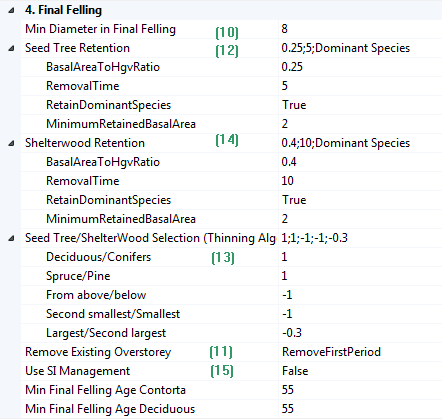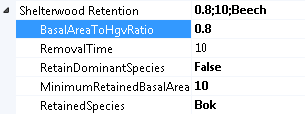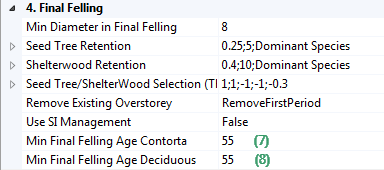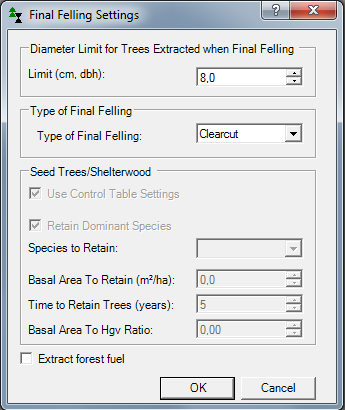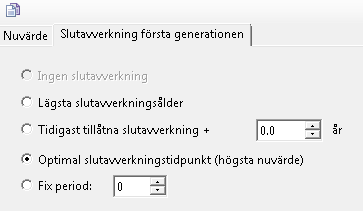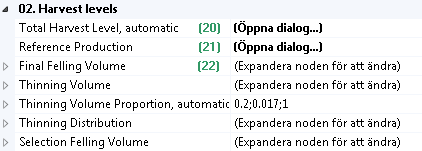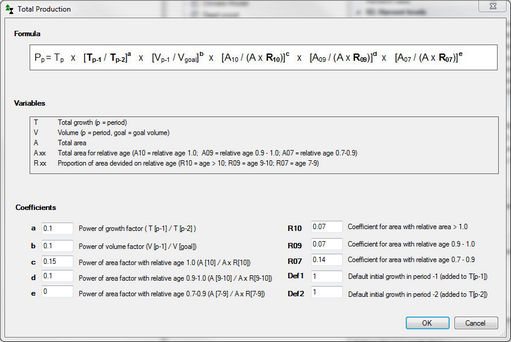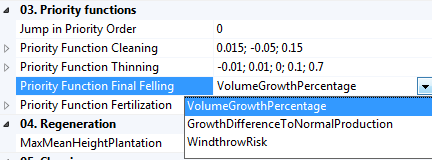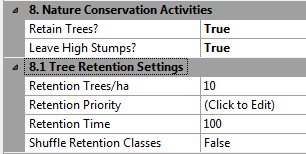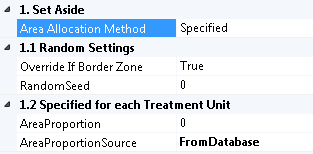Final felling
This chapter describes settings for final fellings.
The execution of a final felling is controlled by settings in the Treatment Model control table. The type of final felling (clearcut, shelterwood or seed trees) is determined by the selected regeneration method (in the Regeneration section). For a given type, details are specified in the Final Felling section (Figure 2).
The execution of a final felling is controlled by settings in section "4. Final Felling" in control table Treatment Model (Figure 1). The timing of thinnings is determined both by the thinning guide used (see below), and by setting in control table Treatment Program Generator in PlanWise, and control table Scenario Settings in RegWise.
Figure 1. Treatment Model control table, Final Felling section (the order can vary).
Min Diameter Final Felling (10) specifies the minimum diameter (dbh) of a tree to be harvested. The default is 8 cm. Smaller trees are left on the site but will not be part of the following stand rotation, and they cannot be harvested as biofuel. Instead these small trees are added to the litter layer, used in the soil model (read more about carbon analyses in Heureka Wiki)
Remove Existing Overstorey (11) regulates how shelterwood, seed trees or retention trees (trees left for the next rotation) will be handled. With the latest template for stand register, you will also be able to specify suggestions for treatments and control how they are used in each stand. Existing trees retained for nature conservation can also be treated separately in the new version.
Under Seed Tree Retention (12) kan du specificera hur många träd som ska lämnas kvar i en fröträdsställning genom som är målkvoten mellan kvarlämnad grundyta och medelhöjd. Exempelvis innebär BasalAreaToHgvRatio = 0.25 att kvarlämnad grundyta helst ska vara 5 m2/ha om medelhöjden är 20 m. Minimum Retained Basal Area anger minimikravet, ingen fröträdsställning eller skärm görs om det inte går att ställa kvar en så stor grundyta av det valda trädslaget, som ges av RetainDominantSpecies och eventuellt RetainedSpecies (om RetainDominantSpecies sätts till False väljer man önskat trädslag under RetainedSpecies, se exempel figur 3).
Under Seed Tree Retention (12) you can specify the number of trees to be left in a seed tree stand in BasalAreaToHgvRatio, the target ratio between retention basal area and mean height. For example, BasalAreaToHgvRatio = 025 means that the basal area of the retention trees should be 5 m2/ha if the mean height is 20 m. Minimum Retained Basal Area determines the minimum requirement. If the basal area of the selected species is lower than specified in RetainDominantSpecies, and possibly also RetainedSpecies, no seed trees or shelter wood trees are retained. (If RetainDominantSpecies is set to False, you can select tree species under RetainedSpecies, see example in Figure 3).
Shelterwood Retention (14) works in the same way as Seed Tree Retention, but concerns shelterwood instead of seed trees, with other standard values.
Set Use SI Management to True if you have entered values in the Site Index Management column in the stand register (version 3), and you want to use them to govern the minimum age of final felling. If you use the Forest Management Planning Package (FMPP) and have a stand register linked to it with values for the Site Index Management column, the latter will be given precedence. If SI Management is set to False, or SI Management is missing, SIS is used (Site quality index according to site factors).
Figure 3. Example of settings where a tree species other than the dominant species is selected for shelter wood retention.
Under Seed Tree/Shelterwood Selection (Thinning Algorithm Parameters) (13), parameters are set for the harvest algorithm. One of them is by default set as low thinning, see more in the thinning section and thinning on Heureka Wiki. The parameters for tree species choice are not used, only the tree species given as RetainDominantSpecies is retained. |
Timing of final felling is set in the Treatment Program Generator control table in the sections starting with “Treatment Timing” (Figure 1), provided that Management System = Even-aged (or Clear-cut) (1). Tip! If you mark a parameter, an explanation is shown under the control table.
Figure 1. Setting parameters for final felling time.
The earliest time for final felling is determined by the Swedish Forestry Act, "LÅF" = minimum age for final felling according to § 10 of the Swedish Forestry Act, Rotation Age Adjustment Factor (4) and Final Felling Period Min (5), where Rotation Age Correction Factor = Adjustment factor for "LÅF". If this is set to a value less than 1, illegal ages can be analysed. A value larger than 1 gives a general extension of the rotation time. Final Felling Period Min = number of periods that the time for final felling can be delayed compared to MinA, where MinA = LÅF * Rotation Age Correction Factor + 5*Final Felling Period Min
The first allowable period for final felling (Pfirst) is the period when the stand age is at least MinA. This means that a stand being older than LÅF already in its starting position is allowed to be retained for a longer time than young stands (if elsewhere hasn’t been defined). Note that:
The least allowable period of final felling is Pfirst + Final Felling Period Max, i.e.
Final Felling Period Max (2) = number of periods that the final felling can be delayed compared with Pfirst
In PlanWise, a management program alternative is created for each possible age of final felling, until the maximum number of alternatives to be saved is reached.
|
If you click on the “Final felling” button in StandWise, the following dialogue box is shown.
Retention of a shelterwood or seed tree stand is specified in the “Type of final felling” box. When StandWise simulates a treatment in a certain period (in contrast to when all periods are run at the same time after clicking the “Last period” button), you specify the basal area to be retained, not the target ratio basal area/mean height as described above.
You can let StandWise search for an optimal final felling age by clicking “Show present value” (in the Treatment menu). In the “Final felling first generation” menu you can select “Optimal final felling age…” Note! PlanWise does this much better by letting thinning ages and treatments of coming generations also vary, while StandWise in this case only simulates thinning strictly according to the thinning template.
|
You can add restrictions to optimisation models to limit the area or volume to be harvested in final felling in each period. You can also add requirements for evenness that make the final felling volume or area vary less from period to period, or from age to age if it is a tactical model.
You can find an example here: Optimisation model: Example.
|
In RegWise, the total level of harvest (final felling and thinning) is determined either automatically or manually. Each control category or domain is treated separately. Automatically estimating harvest levels and distribution between thinning and final fellingIf you don’t type any values in Final Felling Volume (22), the system calculates appropriate harvest levels, one for each time period. The functions are found under Total Harvest Level, automatic (20) in the Harvest levels section of the Scenario Settings control table (Figures 4 and 5). The function aims at creating a sustainable harvest level that is fairly even over time, considering growth, age class distribution and a so-called production norm (standard yield).
Figure 4. Settings for harvest levels in RegWise (control table Scenario Settings). If you don’t specify any values in Final Felling Volume, harvest levels will be calculated automatically.
Figure 5. The function for estimating total harvest level is in the Scenario Settings control table under Total Harvest Level, automatic. The factors after T are used to control the harvest level, for example by increasing it if the growth increases, or if the volume is higher than the norm volume. If all parameters are set to zero, the harvest level will be similar to the growth.
The function for estimating the production norm is based on a theoretical distribution. This is found under Reference Production (21) and is based on the “P-mallen” (Fridh & Nilsson 1980). This function calculates the proportion of total production that is achieved at a certain relative age, compared to the age when mean growth culminates, which is the same as relative age 1. Based on this, a norm volume is calculated, after adjustment of the proportion of the total production that is thinned (according to a theoretical distribution over the production time, which is set in Thinning Distribution). The difference in the estimated norm volume between two periods is the norm production. The default settings for Total Harvest Level, automatic (Figure 5) implies that if real growth is increasing, the harvest level increases, and vice versa. The estimated harvest level will accordingly be relatively higher with a volume above the norm.
The function Thinning Volume, Proportion automatic is used to distribute the harvest level between final felling and thinning. Note that the estimate of the harvest level is only used for clear cut forestry. Continuous cover forestry is treated somewhat differently (see Continuous cover forestry link). Manual settings of final felling levelsInstead of the automatic level, you can specify harvest levels yourself (Figure 4). These are applied to the analysis area that is part of the actual domain (i.e. the domain linked to the control category). To do this, click to the right of Final Felling Volume (31). A dialogue box is opened where you can specify annual harvest levels for each period (in 1000 m3sk/year). A stand that is mature enough for final felling will not be harvested if it leads to the maximum allowable harvest level being exceeded. If you set a negative value for a certain period, the harvest level will be calculated automatically as above. Selection of standsThe selection of stands for final felling is based on priority functions. The default is relative volume growth; the lower a stand’s relative growth, the higher its priority for final felling.
Figure 6. Selection of priority function in RegWise for selecting stands for final felling (in the Scenario Settings control table). |
The revenues from a final felling are composed of revenues from sawn timber, pulp wood and biofuel (if biofuel extraction is included). Price lists and bucking settings are treated in the Pricelist control table. |
An executed final felling is saved as “Final felling” (abbreviation: “FF”) in the Treatment result variable. If a shelterwood or seed trees are retained, the code is FinalFellingSeedTree (abbreviation: “ST” for SeedTree). Removal of the shelterwood or seed trees is indicated as “RemovalofSeedTrees (abbreviation: RSt). See Heureka Wiki: Definition:TreatmentCode.
The variable ForestData.MinFinalFellingAge defines the minimum age of final felling in a certain period for a given management program, with adjustment by a Rotation Age Correction Factor. MinFinalFellingAge can be changed over time, for example if the tree species is changed after final felling. If you use the climate model, the site quality index (SIS) also changes over time, implying that the lowest final felling age is also changed (in most cases to a lower age) for spruce and pine (the LÅF for other tree species is not dependent on SIS). However, if you use SI_Management, LÅF is fixed (separately) for spruce and pine.
See Results variables, Harvest
|
At final felling, you can retain trees for nature conservation (“eternity trees”), in the NatureConservation control table. This is activated by setting RetainTrees = True. When this is done, you can select some detailed settings. The number of retained trees per hectare can be set in RetainedTreeCount, preferred tree species in RetentionPriority, and the time until removal of the retained trees in RetentionTime.
Figure 7. Settings for retaining conservation trees in the NatureConservation control table. An alternative method is to retain parts of a stand (SetAside, see Figure 8). This has to be done at the start of the prognosis, and is fixed over the whole planning period. No harvest or other treatments are applied in these set-asides (free development). The stand register template has a column, NCarea, where you can specify the proportion of a stand to be set aside. If you want to use these values, you specify AreaProportionSource = FromDatabase. Read more about this under nature conservation set asides.
Figure 8. Settings
|
See also:


